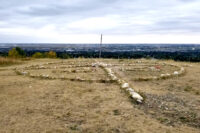Fire chief tips his hat to department’s flexibility in 2020
By Dale Woodard on January 8, 2021.
 Fire Chief Marc Rathwell, acting as the Director of Emergency Management, speaks at a media briefing at city hall last year. Herald file photo by Ian Martens
@IMartensHerald
Fire Chief Marc Rathwell, acting as the Director of Emergency Management, speaks at a media briefing at city hall last year. Herald file photo by Ian Martens
@IMartensHeraldFor those who did Christmas shopping for members of the Lethbridge Fire and Emergency Services, they didn’t need any more head gear over the holiday season.
They already wear many hats.
In a trying 2020 which saw members deal with the COVID-19 pandemic, the ongoing opioid crisis as well as the day-to-day challenges that come with the job, many hats have been worn by all Lethbridge Fire and Emergency Services members.
From his perspective in his first full calendar year as Fire Chief, Marc Rathwell tipped his own cap to the flexibility his crew has demonstrated over the past year.
“I was looking at 2020 and the type of projects and the types of situations we had to manage through this time and I’m a little bit flabbergasted,” he said. “It made me feel like we’ve done more than I ever thought was possible. I always jokingly called the Fire Service the jack-of-all-trades at times. We’re like the marines. We have to be flexible and adaptable for whatever the situation is. I think that’s one of my key takeaways and it doesn’t surprise me. It’s our resiliency, adaptability and creativity and at the end of it all that professionalism from all of our staff at every level, whether they’re administrative or at a deputy chief level, they’re the boots on the ground, the folks going out to EMS calls or doing fire investigations, all of those folks have had make sudden changes at multiple times.”
In the spirit of wearing many hats, Rathwell also dons the Director of Emergency Management title, making him responsible for directing the emergency response for the City, be it a fire, a flood or COVID.
“At the beginning of this it dropped firmly into the emergency management agency’s job in the City to build a response and manage all of this and as we’ve recognized it, the COVID piece actually filters to everybody,” said Rathwell. “There is no exception. Every department, every person – personally and professionally – has had adjustments to make. So instead of trying to build a whole other organization that mirrors our own city, we just said the regular organization has to manage this and we’ll monitor, track and work out PPE issues and all of the other issues that come along. We’ll work with the managers and staff to figure it out and, again, kudos all of our staff and all of our managers. They were all thrown in, whether they had the skills or not, we had to manage the problems so we could continue to support our community.”
In addition to the COVID crisis and the economic impact it brought, Rathwell and his crew also dealt with a local opioid crisis that didn’t slow down in 2020.
“The opioid crisis has never gone away,” he said. “Our staff is still on the front line and dealing with overdoses daily. We’re still going out and saving lives daily. The supervised consumption site might have gone away, but now they’ve moved it into a mobile unit, but our problems in our community are still problems in our community and they continue on. So again, from that perspective kudos to our staff and to all the social services and social development groups who are working hard to try and help these folks.”
The COVID-19 pandemic has impacted training at every level, said Rathwell, adding his first and foremost thought is about the safety of his staff.
“I don’t want to spread a virus, but I also don’t want to get anybody hurt,” he said. “We always want to make sure that’s at the forefront of our thoughts. When we try to train people, whether it’s our regular training or whether it’s our recruit training, we have to put in a lot of effort and work to make sure that it’s safe and it’s making sense because when you have all of these multiple rules from Alberta Health Services, it’s not like I can send everybody home. People still expect an ambulance to show up or a fire truck to show up when there are problems. We have to continue to train and we have to continue to replace folks due to attrition and other reasons.”
Pandemics aside, 2020 saw the beginning of construction of the new westside Fire Hall No. 5, which began in June with the opening slated for June 2021.
“I’m very excited about this,” said Rathwell. “It’s a great step for our community. We’ve got quite a few people living on the westside and we’ve only had five staff over there to manage that. We have to flow everybody from other parts of the city over. Now, we’ll have two stations there for that initial response on the westside and I think our city council has done a magnificent job recognizing that and pushing this forward. It’s a nod to fact we’re growing, not like Calgary or anything like that, but we’re growing and we need to make sure the resources are there to manage the issues.”
This year, the City faces another challenge, keeping its EMS dispatch local.
They are joined by the City of Red Deer and the Regional Municipality of Wood Buffalo in their plight.
The Government of Alberta’s decision to consolidate ambulance dispatch is planned to take effect on Jan. 12 despite requests by the municipalities to the province to reverse the decision.
The municipalities each receive funding annually from Alberta Health Services to operate local ambulance dispatch through integrated municipal dispatch centres, and by offering to pay for the services, would retain current emergency ambulance dispatch services at no cost to the province.
“I believe we are a truly integrated service,” said Rathwell. “Those folks who are on the fire apparatus or on the ambulance, they wear both hats. They wear the fire fighter hat and they wear their paramedic’s hat and very few communities can boast that, and I truly do. These folks, when they show up, if it’s an EMS or an ambulance call to a person’s residence and the fire apparatus shows up, people still, to this day, (ask) ‘Why the heck is a firetruck here? We called for an ambulance.'”
But depending on how the call is processed and the severity of the call, said Rathwell, they’ll send those additional resources.
“Especially if the fire apparatus can get there faster because we know time counts on these calls and we want to make sure the community is safe and if we can save a life, we’re going to do it and if that’s how we do it, that’s fine by me. Those firefighters are jumping off with all the same equipment they have on an ambulance, they just can’t transport. But the ambulance is on its way and it gets there as quickly as it can and we do the best we can to mitigate the issue.”
A program that started several years ago, Lethbridge Fire and Emergency Services cancer mitigation program continued in 2020 and will keep going into 2021.
“We’ve been able to really ramp it up on the last couple of years,” said Rathwell. “That will be a piece that never stops. This goes back to safety as a key. We’ve seen how many firefighters across North America are impacted by cancer. If you ever get the chance to attend a firefighter memorial, and this is the part that resonates with me, 95 per cent of those folks are cancer-related. So, every little bit I can do to engineer in or work with our crews and develop policies and processes that protects them from those exposures, I hope, as a fire prevention officer, that I can mitigate a lot of issues for folks down the road.”
With the calendar flipping to 2021, Lethbridge Fire and Emergency Services has put out postings for its last recruitment class which will fill up Station 5, said Rathwell.
“What we’ve done over the last couple of years is over-hire because you don’t want to just hire the whole station the day before. We’re not big enough to do a really big class of recruits, we are limited. We’ve slowly built up our numbers so this last group that comes in will be dispersed among all the stations, but it’ll give us the numbers so we can fill all of the stations.
“There is a lot of pre-planning, so this has been going on for years to prepare for this. I’m fortunate to be the chief who will be there to watch the doors open. I’m excited about that and I’m excited we’re providing more numbers on our fire resource side and our EMS side. To me, it’s about safety and I want to make sure our community is protected and safe and I want to make sure we’ve got appropriate numbers to manage all of that.”
Though the final numbers haven’t been crunched, Rathwell said 2020’s call volume is similar to the previous year.
“Our numbers are looking pretty much the same as last year only because we had such a slowdown in the early part of COVID. We didn’t do a lot of EMS calls because it slowed down for a little bit. But now they’ve ramped right up and we see some pretty high days. Our fire crews are doing around 5,500 medical first responses and about 1,200 fire calls in the city, annually.
“If you divide that up into a daily piece or a monthly piece, just the medical first response calls, that’s around 460 calls a month by our fire crews. Then our EMS call volume sits at around 17,000 annually. That’s what our ambulances are doing in the city. On a daily basis, our crews are running pretty steady and I’m sure people hear the sirens going all the time. We’re busy, but we’re very efficient at what we do. The key to all of this is our staff and I couldn’t be prouder of all our crews and how they’ve picked up their game to deal with COVID on top of everything else.”
Follow @DWoodardHerald on Twitter
3-2




